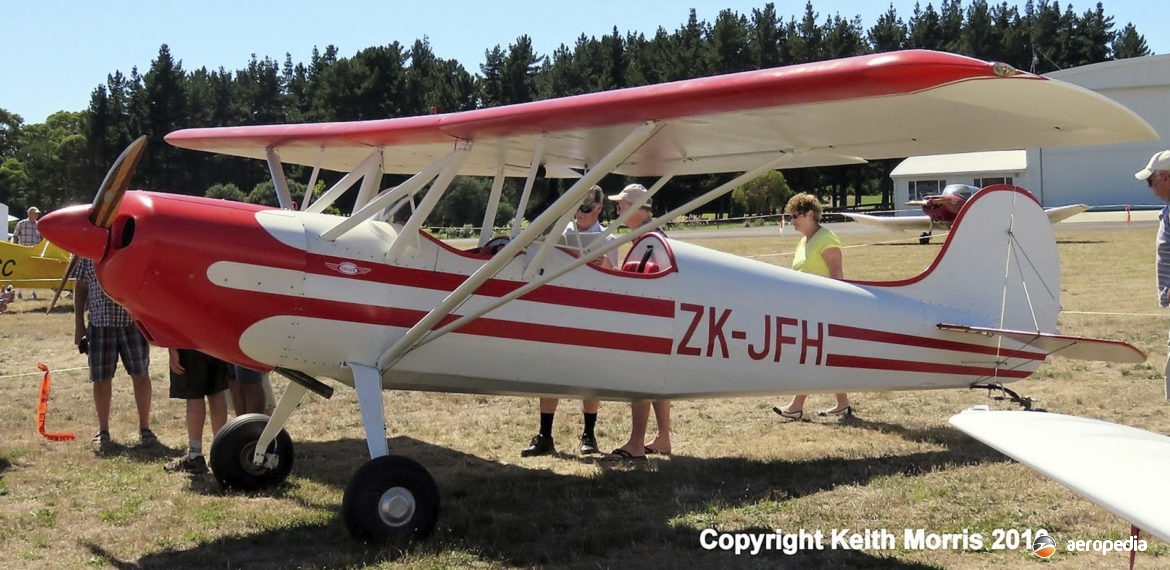Photograph:
Bakeng Deuce ZK-JFH (c/n AACA.586) in New Zealand (Keith Morris – NZCIVAIR)
Country of origin:
United States of America
Description:
Two-seat light sport amateur-built parasol-wing aircraft
Power Plant:
One 93 kw (125 hp) Lycoming O-290-G four-cylinder horizontally-opposed air-cooled engine
Specifications:
- Wingspan: 9.25 m (30 ft 4 in)
- Length: 6.32 m (20 ft 9 in)
- Height: 2.44 m (8 ft)
- Wing area: 12.8 m² (138 sq ft)
- Max speed at sea level: 233 km/h (145 mph)
- Max cruising speed at sea level: 225 km/h (140 mph)
- Max rate of climb at sea level: 610 m/min (2,000 ft/min)
- Service ceiling: 5,180 m (17,000 ft)
- Range with max fuel: 482 km (300 miles)
- Empty weight: 407 kg (898 lb)
- Loaded weight: 680 kg (1,500 lb)
History:
The Bakeng Duce (later known as the Deuce) was designed by Gerald Bakeng in Everett, Washington State in the United States as a high-performance parasol-wing light homebuilt for amateur builders, construction of the prototype commencing in October 1969 and being completed six months later. The first flight was undertaken on 2 April 1970. Subsequently it was displayed at a number of aviation events, including that of the Experimental Aircraft Association at Oshkosh in Wisconsin where it received the Outstanding New Design and Design Improvement Awards in 1971.
In 1972 a new model known as the Double Duce appeared, being a biplane variant, and this could be fitted with engines up to 164 kw (220 hp). The wing was a braced parasol of composite wood and steel tube construction, with fabric covering. The fuselage was welded steel tube with fabric covering, the tail unit also being welded steel tube with fabric covering. The undercarriage was non-retractable.
Plans were made available for the Duce and Double Duce and more than 200 sets of drawings had been sold by 1977.
First of the type to appear in this region was built by John Hansen in New Zealand as ZK-JFH (c/n AACA.586), a parasol wing variant which was first registered to its owner at Te Awamutu on 20 April 1990, which was never completed, and which was struck off the Register in September 2005. It seems the builder was of the view at that stage that the design needed further development before it would be suitable to meet his purposes.
Mr Hansen, a licensed aircraft engineer, subsequently made a number of major changes to the design to overcome perceived problems with the type. Construction of the original machine was never continued. Mr Hansen started with a new aircraft which became known as a Hansen Duce, mainly because it varied extensively from the original design. The new aircraft was registered on completion on 13 December 2012, being test flown by Noel Kruse. This aircraft was powered by a Lycoming O-320 engine providing 119 kw (160 hp).
Mr Raymond Ball of Napier, New Zealand, also commenced construction of a Duce but this aircraft was never completed either.
An example was nearing completion in Melbourne in 2013 but is not known to have been registered yet.
It should be noted that the aircraft has often been referred to as the Duce or the Deuce.
In more recent times rights to the design were obtained by Bakeng Deuce Airplane Factory in 1999, the name of the aircraft being changed from Duce to Deuce to indicate aircraft built to new plans. This new model introduced a new canopy opening forward to ease entry and exit and full weather protection. CAD plans became available and improvements were made to the design, including a re-designed rudder, re-design of the elevator controls, rudder pedals and brakes, larger fuel tanks and re-designed seats.

